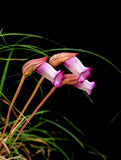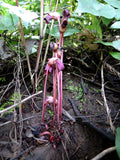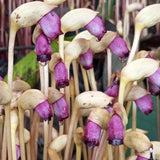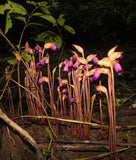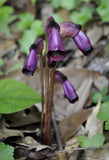Aeginetia indica is a holoparasitic plant that relies on other plants for its nutrients. Common host plants include various grasses (Poaceae), such as Miscanthus and Saccharum (sugarcane), as well as plants from the families Cannaceae, Commelinaceae, Cyperaceae, Juncaceae, and Zingiberaceae. It specifically parasitizes the roots of these plants. Place the seeds in the same soil as the host plant. Maintain a soil temperature around 70F. Keep the soil barely moist but don't soak the soil.
Product Description: Aeginetia indica Seeds — Ghost Blossoms of the Forest Floor
Plant a seed of whispering wonder: Aeginetia indica, known as the Forest Ghost Flower or Indian Broomrape, is a rare parasitic marvel whose ghostly blooms emerge from the soil like living poetry, connecting culture, pollinators, and forest shadows in one fragile package.
Bloom Color, Fragrance & Growth
-
Bloom Color: Striking tubular blossoms in shades of reddish-purple to deep violet, reminiscent of miniature pipes, emerge horizontally from forest duff in mid to late summer—an unexpected flourish of color from a leafless stalk.
-
Fragrance: These floral apparitions emit a subtle, haunting scent—just enough to intrigue pollinators without overwhelming the forest hush.
-
Hardiness: Native to moist tropical and subtropical forests across Asia, it's unlikely to survive frost—best suited to environments comparable to USDA Zones 10–12. Its habitat demands are unique and rooted in forest understory and shade.
Parasitic Life & Pollinator Partnership
-
Root Parasite: A.* indica* lives without chlorophyll, attaching underground to the roots of various grasses, gingers, and similar plants—drawing sustenance in poetic dependency.
-
Specialized Pollination: Its bright blooms are pollinated almost exclusively by female Ceratina bees (small carpenter bees) that nest within the same host stems, forging a rare ecological bond: parasite, pollinator, and host intertwined.
Cultural & Folkloric Significance
-
Forest Ghost & Poetic Muse: Revered in the Eastern Himalayas and Japan, this plant appears in ancient poems like the Manyōshū as “Souhigusa,” a symbol of reflection and memory.
-
Ritual Offering: In Nepal, it blooms into ritual spaces—placed on altars during festivals like Teej as a living emblem of deities Shiva and Parvati.
Growing Notes & Garden Enchantment
-
Cultivation Challenge: Notoriously exacting, these seeds demand both a compatible host plant (like ginger or Miscanthus species) and moist, shaded conditions—ideally in a terrarium or greenhouse setting.
-
Garden Storytelling: Grow not just a flower but an elusive narrative—a phantom of the forest floor that invites curiosity, reverence, and mystery.
Why These Seeds Are Magical
-
Spectral beauty: Deep purple, tubular blooms rising whisper-thin from the soil—forest drama in miniature.
-
Pollinator intimacy: A secret handshake between parasite and its bee pollinators—a rare and fragile ecological duet.
-
Cultural resonance: A token of poetry, faith, and whispered legend—from shrine to anthology.
-
Botanical rarity: Few are cultivated—making each bloom a rare glimpse into a hidden world of parasitic art.
Plant Aeginetia indica seeds if you wish to grow more than a flower—grow a living memory of forest lore, hidden partnerships, and quiet wonders.






